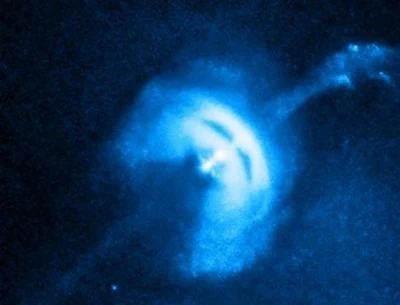To
Vela κρύβεται πίσω από μια «μάσκα» αερίων και περιστρέφεται πιο γρήγορα από
έλικες ελικοπτέρου. Credit: NASA/CXC/Univ of Toronto/M.Dur
Το
διαστημικό τηλεσκόπιο Chandra της NASA κατέγραψε εικόνες από ένα από τα πιο
ενδιαφέροντα άστρα νετρονίου που έχουν εντοπιστεί μέχρι σήμερα. To Vela
βρίσκεται σε απόσταση χιλίων ετών φωτός από τη Γη και είναι ό,τι απέμεινε από
ένα μεγάλο άστρο που καταστράφηκε πριν από δέκα χιλιάδες χρόνια σε μια έκρηξη
σουπερνόβα. Το Vela έχει διάμετρο μόλις 20 χλμ και περιστρέφεται με τρομερή
ταχύτητα.
This movie from
NASA's Chandra X-ray Observatory shows a fast moving jet of particles produced
by a rapidly rotating neutron star, and may provide new insight into the nature
of some of the densest matter in the universe. The star of this movie is the
Vela pulsar, a neutron star that was formed when a massive star collapsed. The
Vela pulsar is about 1,000 light years from Earth, spansis about 12 miles in
diameter, and makes over 11 complete rotations every second, faster than a
helicopter ...
Σύμφωνα
με τους υπολογισμούς των ειδικών το άστρο κάνει 11 περιστροφές/δευτ. - δηλαδή
κινείται πιο γρήγορα από ό,τι οι έλικες ενός ελικοπτέρου! Καθώς περιστρέφεται
εκτοξεύει φορτισμένα σωματίδια. Μυστήριο επίσης αποτελεί το γεγονός ότι γύρω
από το Vela έχει δημιουργηθεί ένα νέφος καυτού αερίου που έχει την εμφάνιση
μάσκας. Η όψη του άστρου με τη «μάσκα» οδήγησε τους ειδικούς στο να το
ονομάσουν «Το Φάντασμα της Όπερας».
Τα
πάλσαρ
The supernova that
formed the Vela pulsar exploded over 10,000 years ago. This optical image from
the Anglo-Australian Observatory's UK Schmidt telescope shows the enormous
apparent size of the supernova remnant formed by the explosion. The full size
of the remnant is about eight degrees across, or about 16 times the angular
size of the moon. The square near the center shows the Chandra image with a
larger field-of-view than used for the movie, with the Vela pulsar in the
middle.
Τα
άστρα νετρονίου που είναι πιο γνωστά με τον όρο «πάλσαρ» είναι σώματα υψηλής
πυκνότητας και σχηματίζονται από άστρα τα οποία έχουν ολοκληρώσει τον κύκλο της
ζωής τους και καταρρέουν. Όλα τα πάλσαρ εκπέμπουν δέσμες ακτινοβολίας γ από
τους πόλους τους και καθώς περιστρέφονται γίνονται ορατά από τη Γη ως
περιοδικές, σύντομες λάμψεις ραδιοκυμάτων. Τα πάλσαρ εκπέμπουν την ακτινοβολία
με σταθερό ρυθμό. Ορισμένοι μάλιστα τα περιγράφουν ως «κοσμικούς ραδιοφάρους».




